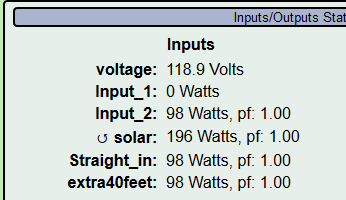What happens when you add an extension to a CT is that the resistance of the lead increases.
At 500 Watts, assuming 120V and near unity power factor, the primary current would be 4.17A. The CT would produce .00417A or 4.17mA. 4.17mA through IoTaWatt’s 20 Ohm burden will produce 83.4mV. The resolution of the ADC is about 780uV.
Cat6 cable is 23 or 24 Ga copper. 75 feet would be 150 x .02567 = 3.85 Ohms, add that to 20 Ohm burden and you get 23.85 Ohms. That’s about a 20% increase in power needed to drive the same current. The ECS1050 can easily do it. Older IoTaWatt have 24 Ohm burden resistors and produce the same results as the 20 Ohm with the same calibration.
So I cannot understand how adding 3.85 Ohms makes a 10% difference in voltage across the IoTaWatt burden resistor. It would need to drop the current 10%. Remember that. The CT would need to produce 10% less current for the same primary current.
Cue an ECS0625 or SCT006. These little CTs have a power problem. That’s why they don’t perform to their basic rating with anything over a 10 Ohm burden. They can’t produce the power that is dissipated in a 20 Ohm burden. So as you move toward these little CTs, you actually create a bigger problem with the added resistance of the extension, which is trivial to the ECS1050.
I had tried Cat5 cable at 100 feet with great results. I don’t have that handy. What I have are two headphone extensions 25’ + 15’ = 40 feet. The wire in these is lighter than cat6. Hear are two ECS1050s clamped around the same wire.

Staight_in is plugged directly into the IoTaWatt
extra40feet has the 40’ headphone extension.
The jig is plugged into a Kill-a-watt that read 326 at the time of the screenshot.
My fluke meter was measuring current at 2.812A, times voltage of 117.4 shown that’s 330 Watts.
The load is lightbulbs so power factopr is unity as shown.
The other inputs on the testbench:
Input_2 is an ECOL09 on the same circuit.
Solar is an ECS1050 connected directly and clamped around two turns of the same circuit.
I’m pretty confident in the accuracy at low current. I unscrewed a couple of bulbs leaving just one:

The Kill-A-Watt shows 94 Watts
The Fluke shows .822 Amps x 118.9 Volts = 97.7 Watts.
To me, these numbers are stunningly accurate and consistent.
How about if I change those two ECS1050’s to ECS16100’s?

Just as I expected.


